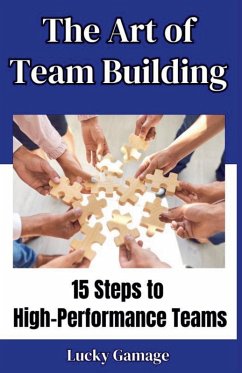The Art of Team Building: 15 Steps to High-Performance Teams offers a comprehensive guide to creating, managing, and nurturing teams that excel. Structured around 15 essential steps, this book provides actionable strategies to guide readers through every stage of team building-from initial assessment to long-term success. Chapter Highlights: Chapter 1: Assessing Your Team: Begin by evaluating your team's strengths and weaknesses, identifying goals and challenges, gathering feedback, and crafting a strategic roadmap for improvement. Chapter 2: Setting Clear Objectives: Learn how to define your team's purpose, set specific goals, and align objectives to create a unified vision for all members. Chapter 3: Selecting Team Members Carefully: Focus on the importance of diversity, compatibility, skills, and experience. Build a balanced team with complementary strengths and effective communication. Chapter 4: Establishing Roles and Responsibilities: Define clear roles and responsibilities to avoid overlap, encourage collaboration, and ensure adaptability within the team. Chapter 5: Communication and Trust-Building: Foster open communication and trust through transparency, conflict resolution, and empowerment, laying the foundation for a successful team dynamic. Chapter 6: Team Building Activities: Engage in practical activities to strengthen cohesion, enhance problem-solving skills, and celebrate successes to maintain motivation. Chapter 7: Leadership and Decision-Making: Identify effective leaders, establish decision-making processes, and empower team members while being open to input and resolving conflicts. Chapter 8: Problem-Solving and Adaptability: Cultivate a problem-solving culture and adaptability to navigate challenges, learn from mistakes, and improve continuously. Chapter 9: Nurturing Professional Development: Invest in training, skill development, mentorship, and career progression to ensure ongoing growth and success for team members. Chapter 10: Feedback and Reflection: Utilize feedback for improvement, celebrate achievements, and make necessary adjustments to enhance team performance. Chapter 11: Continuous Improvement: Promote a culture of continuous improvement by learning from mistakes, implementing changes, and setting milestones based on feedback. Chapter 12: Training and Skill Development: Prioritize ongoing training and development to keep the team skilled and motivated, with a focus on career advancement. Chapter 13: Celebrate Success: Acknowledge and celebrate milestones to boost morale, recognize achievements, and encourage a positive and innovative team environment. Chapter 14: Conflict Resolution: Handle conflicts constructively with effective communication, negotiation, and strategies to maintain team cohesion. Chapter 15: Maintain Work-Life Balance: Support a healthy work-life balance by setting boundaries, preventing burnout, and fostering a supportive work environment. Conclusion: Building high-performance teams requires both art and science. This book provides a structured approach to creating effective, resilient, and dynamic teams. By following these steps-assessing your team, setting clear objectives, selecting the right members, and balancing professional and personal life-you can craft a team that not only achieves its goals but also thrives. Remember, great teams are carefully built and guided to success through continuous growth and mutual respect.
Hinweis: Dieser Artikel kann nur an eine deutsche Lieferadresse ausgeliefert werden.
Hinweis: Dieser Artikel kann nur an eine deutsche Lieferadresse ausgeliefert werden.







